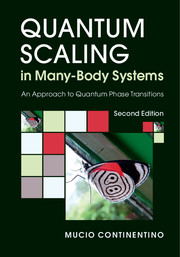Book contents
- Frontmatter
- Dedication
- Contents
- Preface
- 1 Scaling Theory of Quantum Critical Phenomena
- 2 Landau and Gaussian Theories
- 3 Real Space Renormalisation Group Approach
- 4 Renormalisation Group: the ∊-Expansion
- 5 Quantum Phase Transitions
- 6 Heavy Fermions
- 7 A Microscopic Model for Heavy Fermions
- 8 Metal and Superfluid–Insulator Transitions
- 9 Density-Driven Metal–Insulator Transitions
- 10 Mott Transitions
- 11 The Non-Linear Sigma Model
- 12 Superconductor Quantum Critical Points
- 13 Topological Quantum Phase Transitions
- 14 Fluctuation-Induced Quantum Phase Transitions
- 15 Scaling Theory of First-Order Quantum Phase Transitions
- Appendix
- References
- Index
3 - Real Space Renormalisation Group Approach
Published online by Cambridge University Press: 04 May 2017
- Frontmatter
- Dedication
- Contents
- Preface
- 1 Scaling Theory of Quantum Critical Phenomena
- 2 Landau and Gaussian Theories
- 3 Real Space Renormalisation Group Approach
- 4 Renormalisation Group: the ∊-Expansion
- 5 Quantum Phase Transitions
- 6 Heavy Fermions
- 7 A Microscopic Model for Heavy Fermions
- 8 Metal and Superfluid–Insulator Transitions
- 9 Density-Driven Metal–Insulator Transitions
- 10 Mott Transitions
- 11 The Non-Linear Sigma Model
- 12 Superconductor Quantum Critical Points
- 13 Topological Quantum Phase Transitions
- 14 Fluctuation-Induced Quantum Phase Transitions
- 15 Scaling Theory of First-Order Quantum Phase Transitions
- Appendix
- References
- Index
Summary
Introduction
The real space renormalisation group has a wide application in the study of classical critical phenomena. For quantum systems, several versions of the real space renormalisation group have been proposed (Jullien, 1981; Pfeuty et al., 1982; dos Santos, 1982). The real space RG is the most direct way of implementing the scaling ideas presented in Chapter 1. The operation of elimination of degrees of freedom as the system is reduced to blocks of smaller sizes under a change of length scale is directly and intuitively represented as mathematical equations. In particular, the block method has been used to study different problems of strongly correlated systems (Pfeuty et al., 1982) and spin chains (White, 1992, 1993) with different degrees of sophistication. We show here in detail a simple form of this technique applied to the case of the one-dimensional Ising model in a transverse field. The purpose is to illustrate the ideas introduced earlier in Chapter 1 with a concrete example where a quantum critical point is associated with an unstable fixed point. Also, we show how the stable attractors or fixed points can characterise the different phases and how the critical exponents can be obtained. Although the actual values for the quantum critical point and critical exponents that we obtain using a small block are not exact, a procedure is outlined which can be used to improve these results. In this sense, the block method presented here represents a controlled approximation, which can be systematically improved to yield in the limit of very large blocks essentially the correct results. When compared to the k-space version of the RG (to be presented in the next two chapters), the real space version turns out to be in general more difficult to control, in the sense of producing a systematic improvement of the results. On the other hand, this method yields without much effort the attractive fixed points of the different phases, allowing for their characterisation. This turns out to be useful since the nature of the phase transition, whether first or second order, can be determined by exponents calculated in the attractor of this phase (Nienhuis and Naunberg, 1975).
- Type
- Chapter
- Information
- Quantum Scaling in Many-Body SystemsAn Approach to Quantum Phase Transitions, pp. 39 - 45Publisher: Cambridge University PressPrint publication year: 2017



